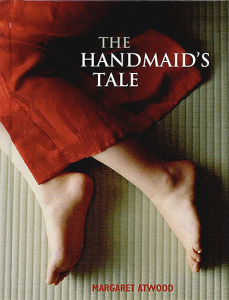Houghton Mifflin Harcourt
311 pages
Review by Corey Pentoney
When I first picked up A Handmaid’s Tale a few years ago—I know, I’m behind the times, here—I did so because it was a classic and had been recommended to me time and time again. As the familiar story goes, I fell in love with it, and have read it every year since, my already slightly ragged copy all the worse for wear for it.
The first time I read the book, the craft of Atwood’s writing was what kept me going, her ability to get into the head of her character, Offred, and stay glued there, is impeccable. With very little else to do as a woman in the Republic of Gilead, Offred spends much of her time scrutinizing every detail of her surroundings and remembering what she can of the past. “A chair, a table, a lamp. Above, on the white ceiling, a relief ornament in the shape of a wreath, and in the center of it a blank space, plastered over, like the place a in a face where the eye has been taken out.” So she describes her living quarters with Fred, from whom she takes her name. Offred’s attention to detail is second to none, and the way she fleshes out the world for the reader keeps you hooked from page to page.
Many authors nowadays could learn a lesson from Atwood in the way that she writes a first-person narrator who is left so completely in the dark. The theocracy in which Offred lives allows women neither pleasure nor entertainment in any way, shape or form, including reading. Her only source of information is the other women who work with her, or her walking partner, Ofglen, who accompanies her on trips to the market, and the gaps in the story and the world that it creates don’t frustrate the reader, but do create a sense of tension in your mind that stays there until the end of the book.
Much of this tension stems from the way that women are treated and the precarious position that Offred has in the world. If she does not produce offspring, she is of no worth. While I’m sure that a plethora of articles and papers have been written on the topic of Handmaid and feminism, Atwood, I think, tackles the topic in a completely different way than many might expect. Instead of an archetypal strong female character overcoming great obstacles, she chooses to show us, through the eyes of one woman, what we have done to women every day, around the world. Atwood implies that when we claim that women need to be “strong” we are already assuming that they are weak.
At the very heart of it, The Handmaid’s Tale hits much closer to home than its dystopian compatriots, such as Brave New World or 1984, and feels like a possibility that could be just around the corner. That said, it’s a fantastic read, and a book I can’t put down, year after year.
***
Corey Pentoney teaches English and Writing in the dark depths of the North Country. When he’s not busy grading papers, he enjoys the fine art of Belgian Waffle decorating, for which he has won several awards.
![[PANK]](https://pankmagazine.com/wp-content/themes/pank/assets/images/pank-logo-large.png)

